VIDEO: What To Do If One Side Is Stronger Than The Other
What do you do if one side is stronger than the other in single leg or single arm exercises?
THE SOLUTION
The solution improving your weaker side is remarkably simple. I outline it in the video below:
Steps to rebalance your sides if one side is stronger than the other
Step 1: Match the weight and reps lifted to what your weaker side is able to do. In other words, just because your right arm is stronger, don’t do more reps with it until both sides are within a couple of reps of each other.
Step 2: When one side is being suborn and isn’t improving as expected, do more total sets on the weaker side. Try this: for one ‘set’, do reps on the weaker side, then do reps on the stronger side, then go back to the weaker side. Then rest and repeat for another set.
Step 3: Train the target muscle groups 2-4x per week. Smaller, weaker muscles can be trained more often (i.e. rotator cuff exercises can be done daily) while bigger stronger muscles take longer to recover between sessions and can be effectively training 2-3x/week. When in doubt, ask someone knowledgeable for advice.
Step 4: Be patient and spend more time focusing on unilateral exercises in your training. Long standing imbalances won’t work themselves out overnight and they won’t go away if you only do bilateral exercises (i.e. barbell bench press vs. dumbbell bench press). In fact, they will probably only get worse. It may take several months of consistent training with a targeted program to achieve parity between left and right. In the grand scheme that’s a drop in the bucket and it’s well worth the investment. When you get back to bilateral exercises you should be able to reach new performance heights over time.
WHY SHOULD I CARE if one side is stronger than the other?
First off, know that some difference between sides is normal and OK. For most people we like to keep the discrepancy to about 5%.
In some unique sports you might have a bigger discrepancy - for example and Right-arm only arm-wrestler, and throwing athlete like a shot putter, and so on. These cases are rare so let’s focus on the majority.
Second, why do we care if one side is stronger than the other? Even strength allows for better symmetry and balance in the body. Allowing weak-spots to fester will generally lead to hole in performance and sometimes injury or altered mechanics over time. Let’s suppose that your left leg is 15% stronger than the right. Chances are that you’ll shift your weight toward the left side during heavy squats. This in turn leads to subtle compensations upstream that can you take you out of position (rotating your pelvis) and put undue stress on one side.
Third, you might care just for aesthetic reasons. If one goal is visual symmetry then these same steps will help you.










